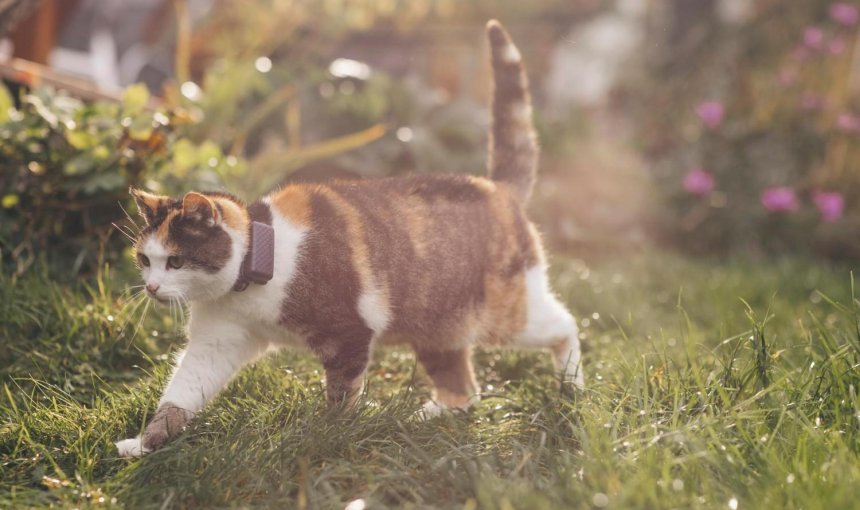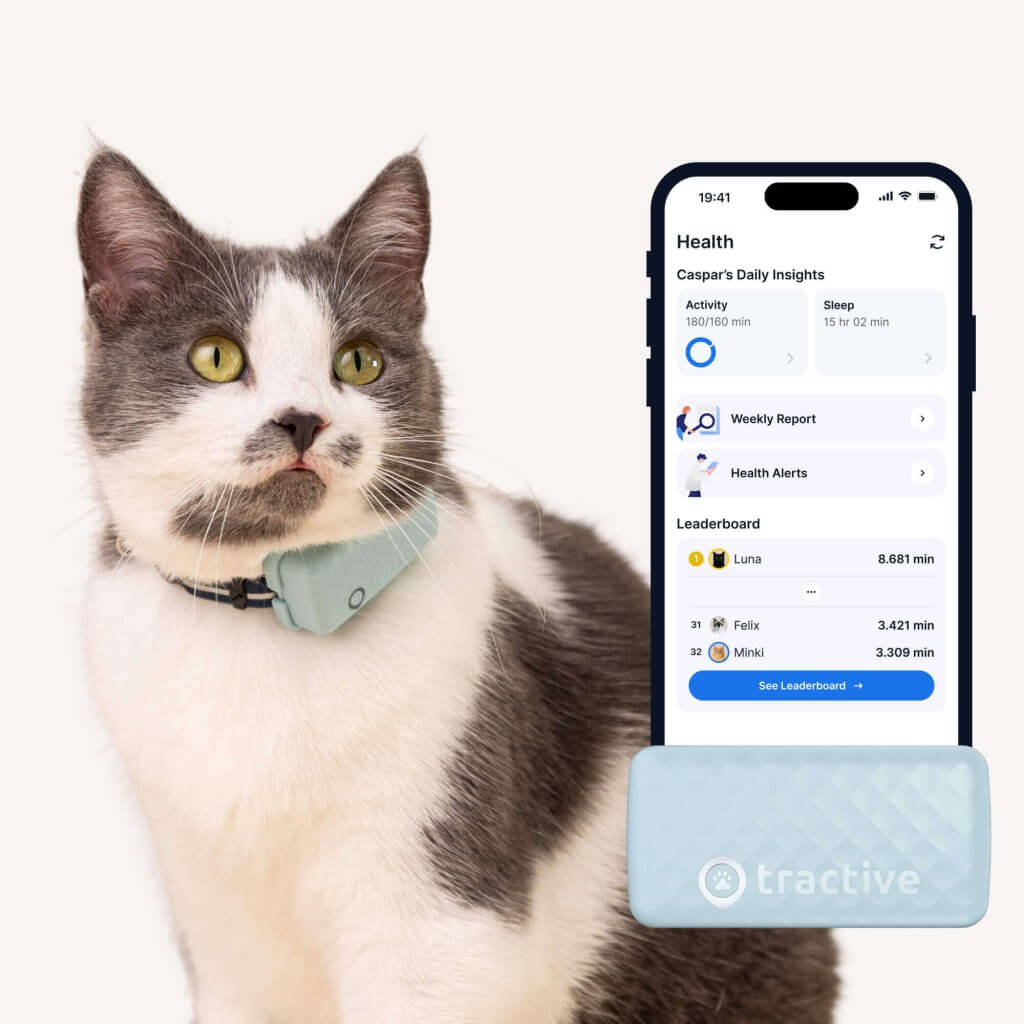How To Keep Cats Cool In Summer
Your cat might be chasing the sun, but even they're at risk for overheating. Here's how to keep cats cool in summer - with & without an AC.

Our feline friends are pretty good at regulating their body temperature. But even they’re at risk for heat stroke – especially on scorching days. Unlike us, they don’t sweat much (only a little through their paw pads!). So they rely on panting and seeking cool spots to stay comfortable. Here’s how to keep cats cool in summer, what steps you can take as a responsible cat parent who might not have AC, and where a smart cat collar can help in an emergency.
Key Takeaways
Always ensure your cat has access to fresh water and multiple cool, shaded spots indoors to escape the heat.
If you don’t have an AC, you can use fans, ice packs, or damp towels to keep your home cool.
Head to your vet if you notice signs like your cat panting excessively, drooling, or seeming lethargic. Your cat might be suffering from heat stroke, which is a potentially fatal condition.
A smart cat collar with Health Monitoring can help you monitor your cat’s whereabouts in real-time and also if they’re experiencing any signs of heat stroke (like from reduced activity or disturbed sleep.)

Find out where your cat spends their time.
Read moreHow to keep cats cool in summer: 4 basic steps
1. Hydration is key
Just like us, cats need plenty of water to stay hydrated. Place several water bowls around your home, in different rooms, to encourage your cat to drink more frequently. Change the water daily, or even twice a day, to keep it fresh and cool. You can even add a few ice cubes to their bowl on really hot days.
Many cats also prefer drinking from running water. A pet water fountain can be a great investment to entice them to drink more. Finally, consider switching up to more wet food into their diet during summer. Wet cat food tends to have higher moisture content than dry kibble.
2. Help your cat stay cool indoors
Cats are masters of finding the coolest spots in the house. Make sure there are plenty of shaded areas indoors where your cat can relax. Close curtains or blinds on windows that get direct sunlight. Also, make sure they can’t access any “cool” spots they might get stuck in. (Like the inside of your fridge!)
Cats also love lying on cool, hard surfaces like tile floors, bathtubs, or sinks. Make sure they can reach these areas easily. For example, some cats enjoy elevated beds that allow air to circulate underneath, keeping them cooler than traditional beds. You could also try buying special cooling mats for pets that absorb body heat. These provide a cool surface without needing refrigeration.
If your cat doesn’t trust cooling mats, use a wet paper towel with cold water to rub across their body – under their armpits, ears, and belly. Don’t rub too hard or try and give your cat an extra “bath.” Just enough to keep them moist. Else, switch to cool, breathable fabrics for their sleeping mat or sleeping areas.
3. Don’t skip out on grooming
Regular grooming can help your cat shed excess fur, which acts as insulation. Brush your cat more frequently during summer to remove loose hair. This is especially important for long-haired breeds.
Next, while it might seem intuitive, shaving a cat’s fur isn’t usually a great idea. (Yes, even if they have dark fur.) Their coat actually provides a layer of insulation against both heat and cold, and it protects their skin from sunburn. Consult your vet if you’re considering it for medical reasons.
4. Switch up your routine (a little)
If you’re used to designated “playtime” at a specific time of day, try and shift it to the early morning or late evening when temperatures are lower. Aim for less strenuous activities throughout the day when the sun’s at its peak.
It’s also a good idea to avoid letting your cat outdoors when the sun is directly overhead. If they’re an outdoor cat, they might be used to unlimited access outdoors. But in these cases, it’s safer to keep them occupied indoors. If you have to, make sure it’s not more than 5-10 minutes, max.
How to keep cats cool in summer without AC
- Keep the indoors well-ventilated
Open windows on opposite sides of the house (if safe and secure) to create a cross-breeze. Close them during the hottest hours to keep hot air out. - Use fans to circulate air
Just make they’re stable and your cat can’t knock them over or get tangled. Never aim a fan directly at your cat for extended periods, as it can dry out their eyes. - Use ice bottles/packs
Freeze water in plastic bottles or use gel ice packs and wrap them in a towel. Place them near your cat’s favorite resting spots. They can lie next to them for a quick cool-down. - Use damp towels
Lightly dampen a towel with cool (not cold) water and gently wipe down your cat’s fur, especially around their head, neck, and belly. Some cats might even enjoy lying on a damp towel. Else, hypoallergenic cat wipes kept in your fridge can also work wonders. - Keep it dark indoors
Keep your curtains, blinds, or shades closed during the day to block out direct sunlight. All of these can turn your home into a sauna within minutes. - Install a lawn sprinkler
If your outdoor cat isn’t afraid of water, a lawn sprinkler can help them stay cool in your backyard. - Use ice cubes
Toss a bunch in your bathtub and keep your bathroom cool and dark for your cats to retreat there. Some cat parents even make ice cubs from the remnants of salmon or tuna cans – your cat might just enjoy licking them.
How to keep outdoor cats cool in summer (especially strays)
If you’re wondering how to keep cats cool in summer if they’re exclusively outdoor stray cats, they’ll need consistent access to water and shade. Set out multiple bowls of fresh water in shaded areas. Check and refill them frequently, as water can evaporate quickly. If you can, provide makeshift shelters or ensure there are natural shaded areas (under bushes, trees) where they can escape the sun. Even a large cardboard box placed under a tree can offer some relief.
If you’re feeding strays, try and do so during cooler times of the day (early morning or late evening) to prevent food from spoiling quickly in the heat. Finally, keep an eye out for any signs of heat stroke in cats and contact a local animal rescue or veterinarian if you notice a cat in distress.
What are the signs of heat stroke in cats?
If you notice any of these symptoms, move your cat to a cooler area immediately, offer them water, and contact your vet right away. You can also apply cool (not ice-cold) damp cloths to their paws and under their armpits while en route to the vet.
- Excessive panting
- Lethargy or weakness, like if your cat seems unusually tired, unable to move, or is stumbling and staggering.
- Vomiting or diarrhea, which can both severely dehydrate your cat
- Drooling
- Bright red tongue and gums, both of which are signs of increased blood flow due to heat.
- Muscle tremors or seizures
While a drop in your cat’s appetite is usually a red flag, do keep in mind that it’s not always out of the ordinary during summer. Your cat might eat slightly less because they’re drinking more water than usual. But if you notice them growing visibly skinnier and/or showing any other signs of illness, drop by your vet for a checkup right away.

Get health alerts for your cat
Our cats can’t always tell us if something’s wrong. But if their tracker detects unusual changes in their routine, you’ll get an alert, helping you catch potential issues early.
Conclusion
Summer is a wonderful time for adventure and sunshine—but when temperatures soar, your cat’s safety comes first. By keeping them hydrated, creating cool indoor spaces, staying on top of grooming, and watching for signs of overheating, you’re helping your furry friend beat the heat and enjoy the season comfortably. And if your cat loves to explore outdoors, a Tractive GPS and Health Tracker gives you peace of mind by letting you monitor their location and activity in real time—so you can make sure they’re staying safe, even on the hottest days. Here’s to a cool, happy summer for you and your feline companion!



